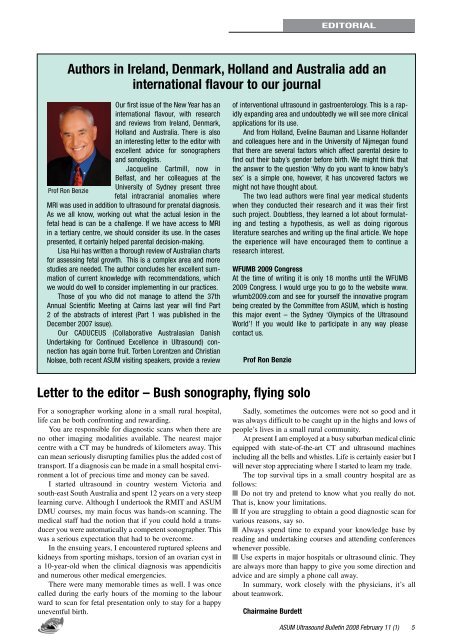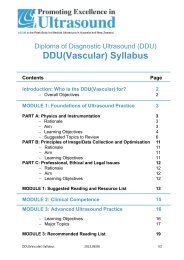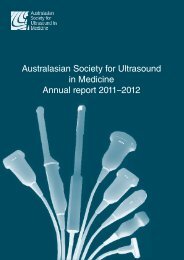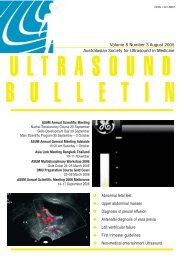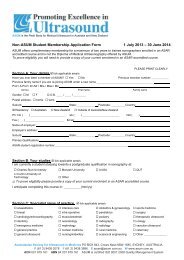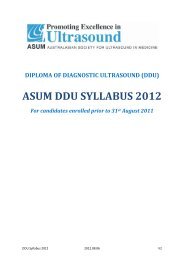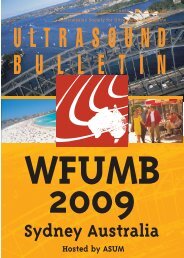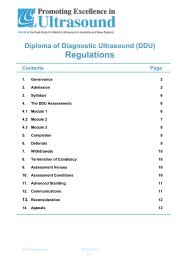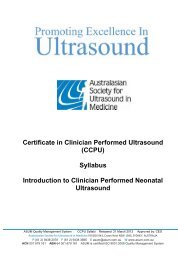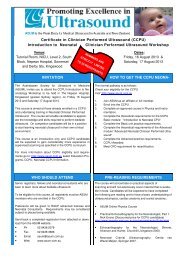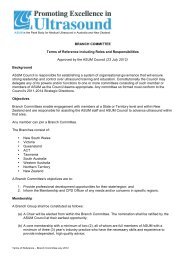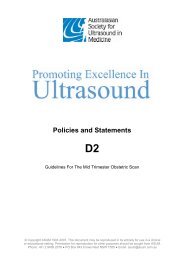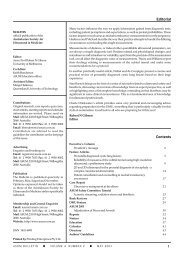Volume 11 Issue 1 (February) - Australasian Society for Ultrasound ...
Volume 11 Issue 1 (February) - Australasian Society for Ultrasound ...
Volume 11 Issue 1 (February) - Australasian Society for Ultrasound ...
Create successful ePaper yourself
Turn your PDF publications into a flip-book with our unique Google optimized e-Paper software.
EDITORIAL<br />
Authors in Ireland, Denmark, Holland and Australia add an <br />
international flavour to our journal<br />
Our first issue of the New Year has an<br />
international flavour, with research<br />
and reviews from Ireland, Denmark,<br />
Holland and Australia. There is also<br />
an interesting letter to the editor with<br />
excellent advice <strong>for</strong> sonographers<br />
and sonologists.<br />
Jacqueline Cartmill, now in<br />
Belfast, and her colleagues at the<br />
University of Sydney present three<br />
Prof Ron Benzie<br />
fetal intracranial anomalies where<br />
MRI was used in addition to ultrasound <strong>for</strong> prenatal diagnosis.<br />
As we all know, working out what the actual lesion in the<br />
fetal head is can be a challenge. If we have access to MRI<br />
in a tertiary centre, we should consider its use. In the cases<br />
presented, it certainly helped parental decision-making.<br />
Lisa Hui has written a thorough review of Australian charts<br />
<strong>for</strong> assessing fetal growth. This is a complex area and more<br />
studies are needed. The author concludes her excellent summation<br />
of current knowledge with recommendations, which<br />
we would do well to consider implementing in our practices.<br />
Those of you who did not manage to attend the 37th<br />
Annual Scientific Meeting at Cairns last year will find Part<br />
2 of the abstracts of interest (Part 1 was published in the<br />
December 2007 issue).<br />
Our CADUCEUS (Collaborative <strong>Australasian</strong> Danish<br />
Undertaking <strong>for</strong> Continued Excellence in <strong>Ultrasound</strong>) connection<br />
has again borne fruit. Torben Lorentzen and Christian<br />
Nolsøe, both recent ASUM visiting speakers, provide a review<br />
of interventional ultrasound in gastroenterology. This is a rapidly<br />
expanding area and undoubtedly we will see more clinical<br />
applications <strong>for</strong> its use.<br />
And from Holland, Eveline Bauman and Lisanne Hollander<br />
and colleagues here and in the University of Nijmegan found<br />
that there are several factors which affect parental desire to<br />
find out their baby’s gender be<strong>for</strong>e birth. We might think that<br />
the answer to the question ‘Why do you want to know baby’s<br />
sex’ is a simple one, however, it has uncovered factors we<br />
might not have thought about.<br />
The two lead authors were final year medical students<br />
when they conducted their research and it was their first<br />
such project. Doubtless, they learned a lot about <strong>for</strong>mulating<br />
and testing a hypothesis, as well as doing rigorous<br />
literature searches and writing up the final article. We hope<br />
the experience will have encouraged them to continue a<br />
research interest.<br />
WFUMB 2009 Congress<br />
At the time of writing it is only 18 months until the WFUMB<br />
2009 Congress. I would urge you to go to the website www.<br />
wfumb2009.com and see <strong>for</strong> yourself the innovative program<br />
being created by the Committee from ASUM, which is hosting<br />
this major event – the Sydney ‘Olympics of the <strong>Ultrasound</strong><br />
World’! If you would like to participate in any way please<br />
contact us.<br />
Prof Ron Benzie<br />
Letter to the editor – Bush sonography, flying solo<br />
For a sonographer working alone in a small rural hospital,<br />
life can be both confronting and rewarding.<br />
You are responsible <strong>for</strong> diagnostic scans when there are<br />
no other imaging modalities available. The nearest major<br />
centre with a CT may be hundreds of kilometers away. This<br />
can mean seriously disrupting families plus the added cost of<br />
transport. If a diagnosis can be made in a small hospital environment<br />
a lot of precious time and money can be saved.<br />
I started ultrasound in country western Victoria and<br />
south-east South Australia and spent 12 years on a very steep<br />
learning curve. Although I undertook the RMIT and ASUM<br />
DMU courses, my main focus was hands-on scanning. The<br />
medical staff had the notion that if you could hold a transducer<br />
you were automatically a competent sonographer. This<br />
was a serious expectation that had to be overcome.<br />
In the ensuing years, I encountered ruptured spleens and<br />
kidneys from sporting mishaps, torsion of an ovarian cyst in<br />
a 10-year-old when the clinical diagnosis was appendicitis<br />
and numerous other medical emergencies.<br />
There were many memorable times as well. I was once<br />
called during the early hours of the morning to the labour<br />
ward to scan <strong>for</strong> fetal presentation only to stay <strong>for</strong> a happy<br />
uneventful birth.<br />
Sadly, sometimes the outcomes were not so good and it<br />
was always difficult to be caught up in the highs and lows of<br />
people’s lives in a small rural community.<br />
At present I am employed at a busy suburban medical clinic<br />
equipped with state-of-the-art CT and ultrasound machines<br />
including all the bells and whistles. Life is certainly easier but I<br />
will never stop appreciating where I started to learn my trade.<br />
The top survival tips in a small country hospital are as<br />
follows:<br />
n Do not try and pretend to know what you really do not.<br />
That is, know your limitations.<br />
n If you are struggling to obtain a good diagnostic scan <strong>for</strong><br />
various reasons, say so.<br />
n Always spend time to expand your knowledge base by<br />
reading and undertaking courses and attending conferences<br />
whenever possible.<br />
n Use experts in major hospitals or ultrasound clinic. They<br />
are always more than happy to give you some direction and<br />
advice and are simply a phone call away.<br />
In summary, work closely with the physicians, it’s all<br />
about teamwork.<br />
Chairmaine Burdett<br />
ASUM <strong>Ultrasound</strong> Bulletin 2008 <strong>February</strong> <strong>11</strong> (1)


